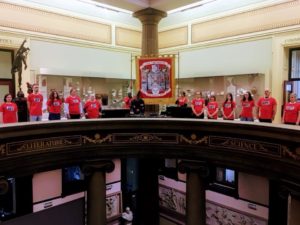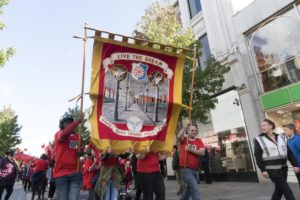The Politics of Cloth & the Lancashire Encounter Parade
The key to working in museum collections and archives, is being able to look. It sounds like a small concept, and perhaps it is, if confused with seeing. Looking is different to seeing in that what you ‘see’ in a gallery or space can be lost in the room itself, or coloured by the amount of people there on that day, the noises in the room, the way work is presented or hung or even just how you feel while being there in that moment. Looking takes time, and looking at things, and finding unexpected ‘stuff’ leads to connections, ideas and finally, being able to see. It reminds me that you have to keep going back to see work, you have to return and look and look and make drawings or photographs until all that looking becomes ‘seeing.’ Really seeing goes beyond how you think it looks from memory or from books or your last visit, or seeing through asking the simple questions – when was it made, what is it made from or how was it made – these answers are usually written and we can look at a piece of paper or text on a wall to receive this information without really interrogating the work. These pieces of paper almost never tell you what the work is saying. The act of repeated looking, takes time of course, it’s so different from watching television or listening to music or even reading a book, in that work doesn’t always entertain or instantly gratify (although it can,) and work doesn’t often reveal itself in the timescales we have become accustomed to, and indeed demand. Museums and galleries require us to return, to really see the work we must return. To go away and think and come back again. To change our mind or to make sense months and sometimes years after that first encounter. These things take time, but what really takes time is the thinking that follows the looking.
The next stage the ‘thinking’ about what you will make, how you will make it and if it will be any good can happen quite quickly, at least it does for me. Once I’ve started on the research I become obsessed, consumed with the work, desperate to find out everything I can, and to have as much time ‘looking’ and thinking as possible. I am always attempting to make connections between the past and the present, often with an eye on the future, a future that is impossible to know of course, but I often picture an artist visiting my work after I’m gone, unwrapping it from a box in a collection or staring at it on a wall in Blackburn Museum and asking the same questions I am asking now. I want to tell them something about us, about me and the place they are visiting. Not as it is for them, but as it was for me. I imagine them encountering my work for this commission in the same way that I have been looking at the banners in the collections of The Harris Museum Preston, and Blackburn Museum and Art Gallery. This thought drives my work for this commission, the idea that I need to leave memories, objects and artworks for our future heritage and museum archives.
I have decided to make a new banner that captures ‘Acid House’ during its thirtieth anniversary and have become very excited about the unexpected overlap between this period and the rituals of the industrial past. I’m particularly interested in the behaviours of communities and their relationship with the cotton mills of Lancashire over time. Historically, this included large processions of people travelling to, and gathering in these spaces for work, This immediately reminds me of the convoys of ravers gathering and winding their way to the locations of the parties at the end of the Eighties and early Nineties and the noise of these factories and mills where cloth was woven, printed or manufactured, and the pride and purpose these communities experienced from Queen Victoria to Voodoo Ray. This is the essence of what I have tried to capture in my banner, my first piece of work for this commission.

The first stop is a visit to Durham Banner Makers, who make traditional hand painted silk banners that are still marched in working class communities to this day. I’ve pulled together all the research I can on process and content to make a new banner for Lancashire Encounter festival, one that will be a live art work, marched in a procession and carried outside in the wind and the elements, exactly as the banners in the collections were when they were painted. Emma reminds me that this is what they are intended for, that the banner has the potential to become a living ‘thing.’ Our banner is beautiful, and after collecting from Emma at their studio I travel with Jenny Rutter from Super Slow Way to visit the banners at Durham Miners Association. It’s an incredible place and represents the area’s history of coal driven industry, with obvious parallels to Lancashire’s cotton heritage. By the time we leave, we are confirming plans for our banner to be paraded in July as part of the annual banner parade in Durham. It’s a day where all that ‘looking’ leads to new ways of seeing, and of meeting new people and making unexpected connections. It’s a day of joy, the first in fact of what becomes a long weekend of absolute joy and excitement as we unveil the work in Preston.
Lancashire encounter is split over two days, the first is a Saturday where I unveil the banner in a performance piece in the Harris Museum on the Saturday, and The Sunday is the procession through the town. The procession is themed around the colour red and the proposition of dreams. My banner is titled ‘live the dream’ after the famous rave outside Blackburn and red is the colour of the silk I have used. It’s a perfect fit.
Before all of this work is delivered however I take part in a pod cast at The Harris on The Friday for ‘Arts Lancashire’
https://artslancashire.org.uk/thegathering/episode-1-finding-creativity-with-jamie-holman/
I am interviewed by Alex O’Toole in front of an audience and we talk about making work, being creative and what it is I’m trying to do. I really enjoyed the discussion and it feels like an opportunity to make visible what I’m making, and that I suppose is the challenge we all face. Being visible in our work and engaging an audience. I am mindful of my audience as I leave, and make final preparations for the weekend that will follow.
Saturday morning finds Alan Outram and I setting up a small P.A. in the museum and preparing for three performances that include Alan leading a small procession and delivering the performative element of the work, playing music using the equipment of the time . A Roland 101, an 808 and other bits and pieces ebb and throb throughout the museum, echoing around the building as the day unfolds. The clothes he’s wearing during the performances, and the ritual of marching is a proposition that the activities of acid house belong to a history of folklore, ritual, dissent and community activism/activity that is ancient, making links to William Blake and his ‘dance of Albion’ and older (stranger) customs of dancing , occupying spaces (fields, factories, woodlands etc ) in an attempt to locate Acid House beyond nostalgia and into a wider, and richer, folk lore tradition . It’s risky, especially as we have student and community volunteers assisting by wearing T shirts I’ve made that say either ‘HOPE’ or ‘JOY” on them, but have banned them from exhibiting any sense of either, with strict instruction that there are no smiles allowed.
The day is a triumph. I am supported and assisted by our studio team of Steve Baldwin and Joe Fossard (who built the P.A.’s for the original parties) and everything runs smoothly. The banner looks incredible in the context of the performance and the public are either intrigued, or engaged , but rarely dismissive. It’s a great day.

The morning of the parade arrives and we gather with the rest of the procession, students and community volunteers have arrived to carry the banner but this time with a twist. We hand out headphones for a ‘silent disco’ and I play the marchers songs from my phone. I start with A Guy Called Geralds ‘Voodoo Ray’ and we find ourselves dancing as we walk. The procession is a joyous occasion and the opportunity to see the banner, doing what it was intended, fills me with pride. The same pride I feel as the tweets, face book and Instagram messages start to come in as we wind our way through Preston, before finally delivering our banner back to the Harris, where we started at the beginning of the weekend.
I realise that the ‘politics of cloth’ are still very much live, still emerging and still define us in so many ways. I am already back to ‘looking’ and am becoming lost in the research and the drawing and the thinking again, preparing for exciting work that will compliment and challenge the banner I have just delivered. This commission has made me realise that despite the challenges of the times we find ourselves in, and the past and future we are trying to make sense of in this confusing present – our mills still empty, our people still struggling as the industrial world shifts around them, that we are still proud communities, still united and still full of hope, joy and pride.
We have much to be proud of. I hope that we can make some of this pride visible in the work I make next.






